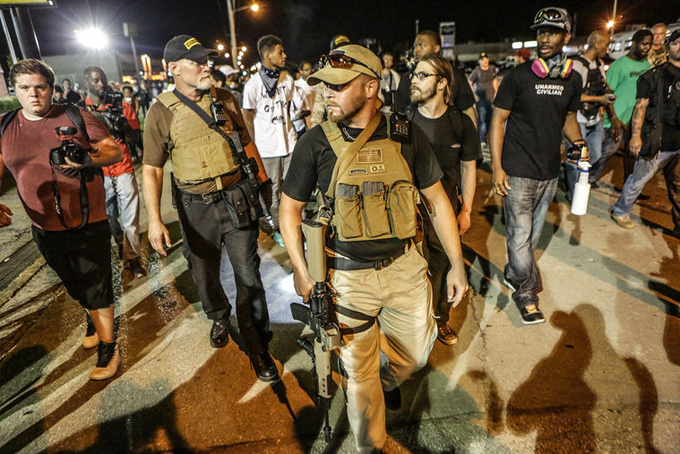
Our reporter was at the Ferguson protest on Monday, August 10 when a group of White men identified with the Oath Keepers group strutted through the throng of protestors. Belmar was on the scene, but neither he nor any of his officers stopped these heavily armed men to see if they had permits. In effect, their mere presence terrorized many protestors – our reporter said they made her fear for her life – but they were not dealt with as a threat by the chief or his officers. No one would argue that a Black man carrying an assault weapon in the same tense situation would have been treated the same way.
“If those had been Black men walking the streets of Ferguson with assault rifles, they would have been thrown to the ground and taken into custody,” our reporter said. “But these guys? Nothing. And at this same protest, people were brutally thrown to the ground and placed under arrest for slinging a little water. You need to tell Belmar he is going to lose all the ground he has made in this community if this keeps up.”
We did as she directed. We asked Belmar why he decided not to stop the Oath Keepers group, check their permits, and interview them for a threat assessment. His media coordinator responded with a statement: “The St. Louis County Police Department is going to consult with the St. Louis County Prosecuting Attorney’s Office about the legalities of the issue. Chief Jon Belmar stated, ‘Their presence was both unnecessary and inflammatory.’”
After Belmar checked with his attorneys, he approached the Oath Keepers in Ferguson the following night, August 11, as captured in a video posted on Alex Jones’ YouTube channel. The Oath Keepers – who had heard, by then, Belmar calling their presence “unnecessary and inflammatory” – said their armed presence was intended to protect a sympathetic reporter, in light of the assaults on several media members at Ferguson protests.
“I get where you guys are coming from, and I get what you stand for. I agree probably with most of it,” Belmar told them. “What I don’t want to have to see is slung exterior weapons. I don’t want anything provocative to churn this up any more than it is.” He declined to discuss the legality of their presence at protests, insisting instead that it was dangerous and counter-productive to his efforts to keep the peace.
It was an impressive piece of diplomatic tap dancing. However much we might be appalled to hear the chief say he agrees with most of what a militia group stands for, he has a major, volatile dilemma on his hands. If he moves too aggressively in an attempt to restrict their 2nd Amendment rights, he risks the truly disastrous – yet all-too-real – possibility of sparking a second protest movement in Ferguson. Can you imagine both Black Lives Matter protestors and the militia movement protesting the same police at the same time in Ferguson? You had better be sure that Belmar has imagined just that scenario.
Our message to the chief is this. We shared it with him directly, first, via his spokesman: “This is a huge deal. It touches on implicit bias in threat assessment. Belmar should really dive deep into this. If he can figure out and then show the country how to train White cops to objectively assess the threats of young Black people – as well as they do grown White people – we will get somewhere.” For if police officers can make a prudent judgment that a White man with an assault rifle at a Black Lives Matter protest does not need to be confronted aggressively, then surely they can be trained to judge prudently when a Black person carrying no weapon at all is not a deadly threat. For if there is one thing – other than outright racism – at the heart of this movement, it is the often fatal consequences of implicit bias in police who assess the degree of threat posed by African Americans. This double standard of police conduct represents continued denial of equal treatment under the law for African Americans and other people of color. It is this denial of justice that is at the heart of the fundamental demands of the Black Lives Matter protest movement.
https://www.stlamerican.com/news/editorials/article_6acde85e-4167-11e5-825d-0730d3bd0745.html
